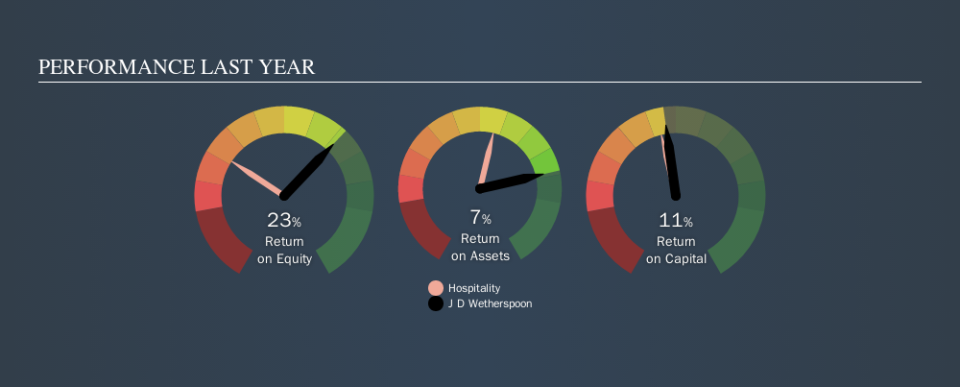A Close Look At J D Wetherspoon plc’s (LON:JDW) 11% ROCE

Today we'll evaluate J D Wetherspoon plc (LON:JDW) to determine whether it could have potential as an investment idea. Specifically, we'll consider its Return On Capital Employed (ROCE), since that will give us an insight into how efficiently the business can generate profits from the capital it requires.
Firstly, we'll go over how we calculate ROCE. Second, we'll look at its ROCE compared to similar companies. Then we'll determine how its current liabilities are affecting its ROCE.
What is Return On Capital Employed (ROCE)?
ROCE measures the amount of pre-tax profits a company can generate from the capital employed in its business. All else being equal, a better business will have a higher ROCE. Overall, it is a valuable metric that has its flaws. Author Edwin Whiting says to be careful when comparing the ROCE of different businesses, since 'No two businesses are exactly alike.
How Do You Calculate Return On Capital Employed?
Analysts use this formula to calculate return on capital employed:
Return on Capital Employed = Earnings Before Interest and Tax (EBIT) ÷ (Total Assets - Current Liabilities)
Or for J D Wetherspoon:
0.11 = UK£132m ÷ (UK£1.5b - UK£327m) (Based on the trailing twelve months to July 2019.)
Therefore, J D Wetherspoon has an ROCE of 11%.
Check out our latest analysis for J D Wetherspoon
Is J D Wetherspoon's ROCE Good?
ROCE is commonly used for comparing the performance of similar businesses. In our analysis, J D Wetherspoon's ROCE is meaningfully higher than the 7.6% average in the Hospitality industry. We consider this a positive sign, because it suggests it uses capital more efficiently than similar companies. Separate from J D Wetherspoon's performance relative to its industry, its ROCE in absolute terms looks satisfactory, and it may be worth researching in more depth.
The image below shows how J D Wetherspoon's ROCE compares to its industry, and you can click it to see more detail on its past growth.
It is important to remember that ROCE shows past performance, and is not necessarily predictive. ROCE can be misleading for companies in cyclical industries, with returns looking impressive during the boom times, but very weak during the busts. This is because ROCE only looks at one year, instead of considering returns across a whole cycle. What happens in the future is pretty important for investors, so we have prepared a free report on analyst forecasts for J D Wetherspoon.
J D Wetherspoon's Current Liabilities And Their Impact On Its ROCE
Current liabilities are short term bills and invoices that need to be paid in 12 months or less. The ROCE equation subtracts current liabilities from capital employed, so a company with a lot of current liabilities appears to have less capital employed, and a higher ROCE than otherwise. To check the impact of this, we calculate if a company has high current liabilities relative to its total assets.
J D Wetherspoon has total liabilities of UK£327m and total assets of UK£1.5b. As a result, its current liabilities are equal to approximately 21% of its total assets. A fairly low level of current liabilities is not influencing the ROCE too much.
What We Can Learn From J D Wetherspoon's ROCE
With that in mind, J D Wetherspoon's ROCE appears pretty good. J D Wetherspoon shapes up well under this analysis, but it is far from the only business delivering excellent numbers . You might also want to check this free collection of companies delivering excellent earnings growth.
I will like J D Wetherspoon better if I see some big insider buys. While we wait, check out this free list of growing companies with considerable, recent, insider buying.
We aim to bring you long-term focused research analysis driven by fundamental data. Note that our analysis may not factor in the latest price-sensitive company announcements or qualitative material.
If you spot an error that warrants correction, please contact the editor at editorial-team@simplywallst.com. This article by Simply Wall St is general in nature. It does not constitute a recommendation to buy or sell any stock, and does not take account of your objectives, or your financial situation. Simply Wall St has no position in the stocks mentioned. Thank you for reading.

 Yahoo Finance
Yahoo Finance 
